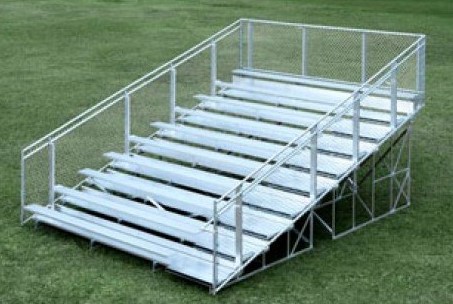 Spectators walking on bleachers that are not IBC-compliant can be hazardou
Spectators walking on bleachers that are not IBC-compliant can be hazardou
When you think about hazards at a football or basketball game, you're probably thinking the players are the only ones at risk. Actually, spectators can also get injured by an unexpected hazard: bleachers .
Think about it. Bleachers are the one thing separating you from the ground, so if they are old or weathered, they may collapse from underneath you. Aluminum bleachers need to be sturdier than regular seats because they take so much abuse from extreme weather and overly excited fans.
Besides needing to be sturdy, bleachers are also difficult to walk on. It's easy to trip or fall between the seats, especially when they are wet or icy. The likelihood of falling is even greater with damaged benches that are past due for maintenance.
Bleacher safety guidelines enacted after injuries reported
In 1999, the Consumer Product Safety Commission reported 22,100 injuries from bleachers that resulted in emergency treatment, with 4,910 victims under the age of 15.
 Bleachers with handrail
Bleachers with handrail
That same year, bleachers came to the center stage of politics. Bill Luther and Jim Ramstad petitioned the Consumer Product Safety Commission to have a safety standard established for bleachers and grandstands. This led to implementing safety standards for bleachers as part of the International Building Code (IBC).
As a facility manager, you've probably dealt with keeping things up to fire code or following certain building codes. Those are established by the IBC. The International Building Code is the standard that keeps America and its buildings some of the safest worldwide. The first edition of the International Building Code was published in 1997, combining the codes from three previous standards to make it easier for builders to follow one rule book.
Since then, IBC has been adopted nationwide, and improvements and updates, including the addition of bleachers, continue making the code even safer. It's now 752 pages long, with guidelines ranging from fire protection systems to smoke control to plumbing fixtures to accessibility for disabled persons. American buildings are safer and more accessible for all due to the IBC standard.
After purchasing IBC-compliant bleachers, keep them in compliance by inspecting and maintaining the different parts: the rails, understructure, seats, steps, and other hardware. Keep records of your inspection and replacement to ensure it is maintained on a regular basis.
Also most facility managers know to double-check state and local building codes. Some states, such as California, have very specific requirements that must be met.
Finding the perfect bleachers
Now that IBC compliance is at the top of your list when looking for spectator seating, there are a few other factors you should look for, including:
- Material: Aluminum bleachers are generally the least maintenance and highest durability. Wooden benches can split and create splinter dangers for guests.
- Bleacher covers: These will protect your seats from weathering and damage, while also providing maximum comfort for guests. Aluminum bleachers are known for absorbing extreme weather, forcing guests to sit on hot or cold bleachers.
- Elevated: Elevated bleachers are raised up above ground level. This makes it easier for guests to see over those sitting in front of them and to see the field.
- Portable: Whether you get portable bleachers or the tip-and-roll kind, this movable seating is ideal for accommodating different crowds and events and going into storage when not in use.
- Railing: Some bleachers come without handrails, but a railing generally keeps guests safer, especially rambunctious children who might be a danger to themselves without them.
Don't let IBC compliance be optional. Find the right bleachers for sale. The last thing you want at your facility is injured spectators due to old, hazardous seating. Let your fans safely enjoy the games and events at your stadium on bleachers that are safe and maintained by making IBC compliance a top requirement.


